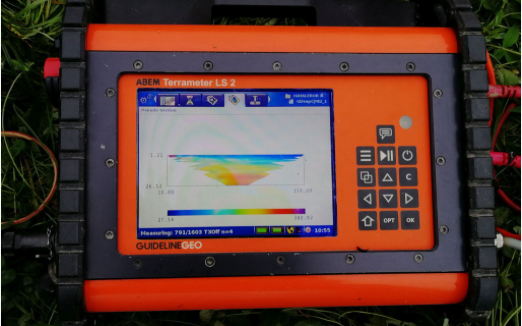Geophysical Mapping of Groundwater Properties for Construction of Transport Infrastructure
Part 2

Construction of transport infrastructure often involves extensive excavation work, making it
crucial to understand groundwater conditions for several reasons as, for example:
• Leaking groundwater can compromise the stability of shafts.
• Groundwater depletion can lead to subsidence in buildings and other infrastructure.
• Increased groundwater gradients can result in the transport of pollutants from
contaminated land.
Assessing the need for protective measures for groundwater in conjunction with new
transport infrastructure is essential. Given the potentially high cost of such measures,
accurate knowledge of groundwater resource locations and the distribution of geomaterials
with varying hydraulic properties is crucial for effective decision-making.
Traditionally, determining hydraulic properties involves drilling accompanied by slug testing
or test pumping, which is costly and provides only point information. However, geophysical
methods such as DCIP (Direct Current Resistivity and Induced Polarization) tomography can
offer spatial information (3D models) about soil hydraulic permeability. MRS (Magnetic
Resonance Sounding) can measure reservoir coefficient and hydraulic transmissivity without
the need for drilling and hydraulic tests.
In a recently completed project, we demonstrated the robustness of DCIP in providing
hydraulic permeability values that align with those obtained from other methods across three
test areas. However, the method's resolution is constrained by the lack of relevant reference
data. While MRS yielded satisfactory results in one of three test areas, its sensitivity to
disturbances limits its effectiveness; hence, borehole and CPT technology measurements may
offer more reliability.
This project aims to further develop tools for producing better groundwater management data
during shaft construction and groundwater protection. The goal is to enhance the
effectiveness and resource efficiency of groundwater management in transport infrastructure
projects, thereby reducing costs and minimizing environmental impact.
We are collaborating on this project with the Hydrogeophysics group from Aarhus
University, Denmark as well as the German Helmholtz Center for Environmental Research
(UFZ), the Federal Geological Survey of Germany (BGR), and the Leibniz institute for
Applied Geophysics (LIAG). The project is funded by and closely aligned with Trafikverket.
Contact: tina.martin@tg.lth.se
